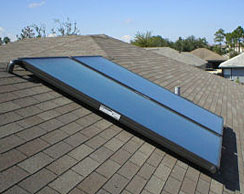The Science Channel: “How It’s Made!” – Solar Water Heaters
 I’m not sure how many of you out there watch the Science Channel but you may have heard of a show called “How It’s Made”. Well, last Thursday night (12/29) they included a segment on solar water heaters.
I’m not sure how many of you out there watch the Science Channel but you may have heard of a show called “How It’s Made”. Well, last Thursday night (12/29) they included a segment on solar water heaters.
Our friends at AET were highlighted in this episode so be sure to check it out whenever they run it again. It’s good to see our industry gaining some “air-time”. Hopefully, educational opportunities like this one will encourage millions of homeowners and business owners to seriously give solar hot water some consideration.
If you did happen to catch the episode, please feel free to leave your thoughts on it in the comment section below!
Dr. Ben
2 Responses to “The Science Channel: “How It’s Made!” – Solar Water Heaters”
Comments
Read below or add a comment...

Dr. Ben,
I spent several hours online today and was only able to find two manufactures that make drain down systems similar to your design, but they both heat the same hot water tank that my electricity or gas heats. Can you recommend any manufacturers or dealers that produce a product fitting your designs?
I read the discussion on air venting, to accommodate the rise and fall of the water level. Why not use a tubular diaphragm inside of a pipe, similar to what you find in many domestic water storage tanks, except much smaller and longer. On a residential system it would only need to breath a maybe a cubic foot? A very small breather whole could adjust if the diaphragm collapses or over inflates.
Kirk Anderson
Kirk,
Single tank solar water heaters are by far the most common. Single tank drain back designs have a small drain back reservoir in addition to the water heater. Some have a heat exchanger inside the drain back tank, so you can use an ordinary water heater, and some have the heat exchanger inside the water heater, which has to be a special unit. Either of these designs is preferable to a glycol system. AET supplies both of these single tank versions, as do others.
I prefer a two tank solar system. The “solar” tank collects only the solar energy, then transfers that energy to the regular water heater. I am not familiar with companies that make solar-only tanks for two tank systems. We will have our new model out sometime before spring, but I don’t know where to direct you before then.
In 99% of the cases, a knowledgeable solar dealer with all the trade skills is required to install a solar system. There are qualified DIYers out there, but they are a small fraction of solar owners, just as there are few people who do their own car repairs.
An air vent is used to keep the solar tank at atmospheric pressure. It is not needed to accommodate the rise and fall of water in the tank, which consists of simply swapping the air and water around inside the collectors and tank with no change in volume. However, when you heat the air in the collectors, and then the water when it reaches them, there will be a volume change, which is vented out of the system. Likewise at night when the system cools down, the air inside will contract and suck air back into the system. Any kind of diaphram constitutes a pressure regulator. If the drain back reservoir is a pressure vessel, then it will have a pressure relief valve on it and the collector loop is closed. Small systems can work well this way, but for big systems the cost is too great for a pressure vessel, so we vent the system.
I hope this helps.
Ben Gravely